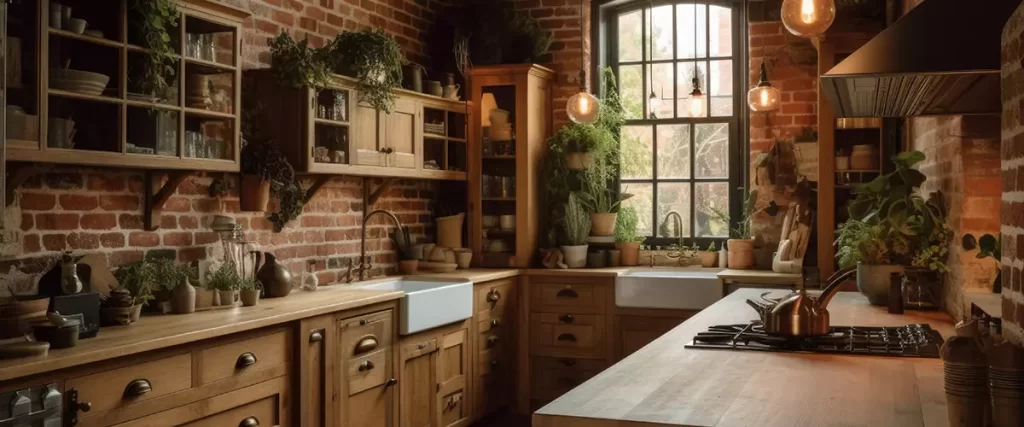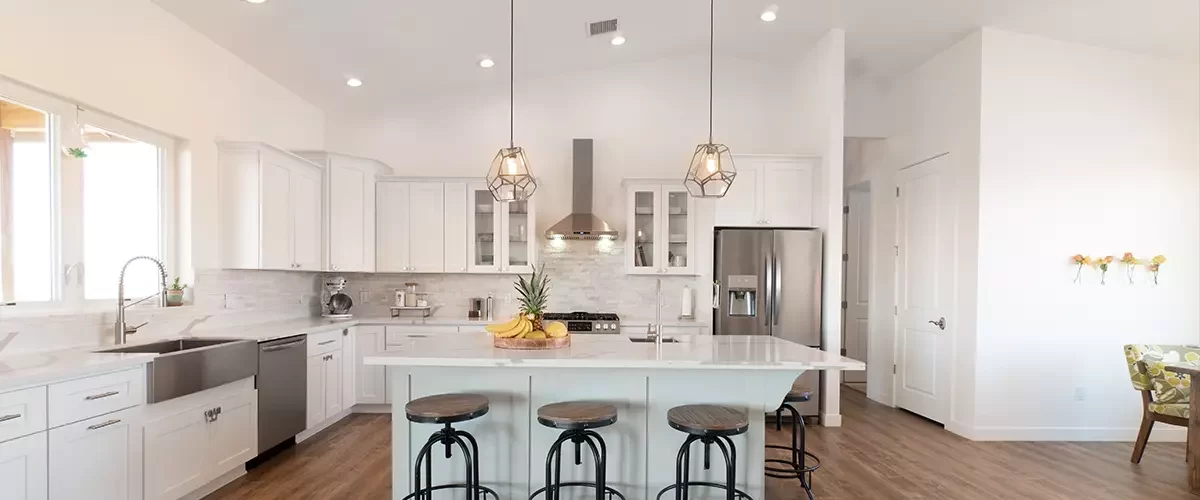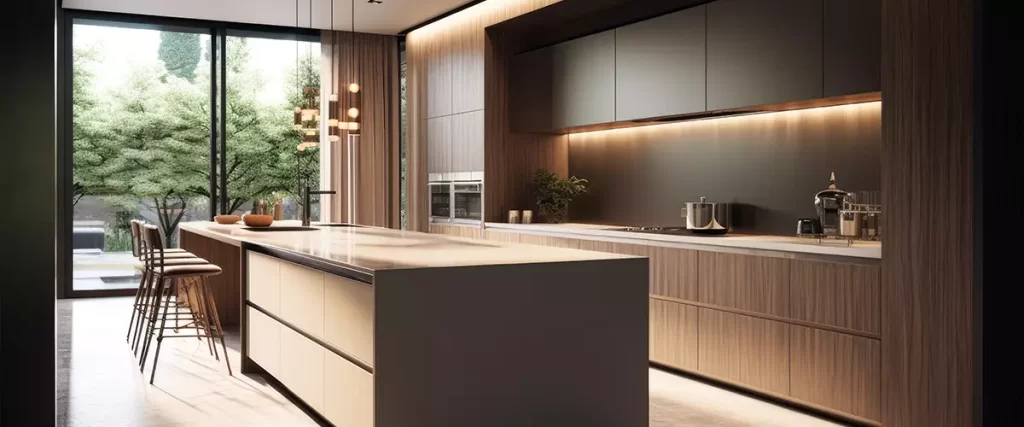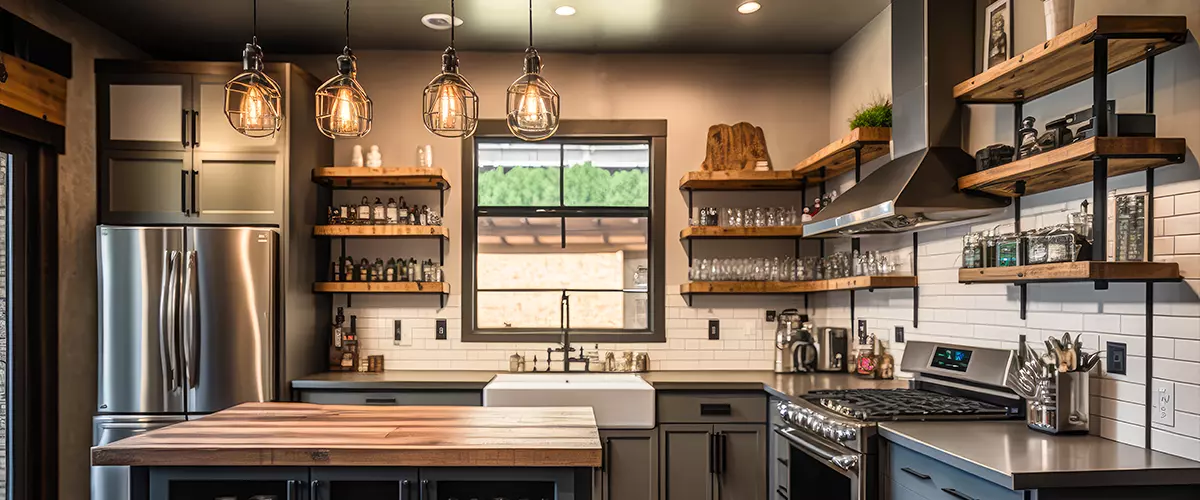Have you ever struggled with determining the best lighting for a kitchen?
Studies reveal that a well-illuminated kitchen not only makes cooking easier but can also significantly enhance the look and feel of your space.
This blog post will guide you through expert tips and innovative ideas to select the best lighting options for your kitchen – from ambient to task, accent, and everything in between.
Ready to illuminate your culinary space like never before? Let’s dive in!

Key Takeaways
- Kitchen lighting can be varied using different sources and layers to improve ambiance and function.
- Task lights make cooking activities easier by adding focused light in key areas, like under cabinets.
- Features, like countertops or backsplashes, shine when highlighted with accent lights.
- The size and layout of your kitchen impact where you put ambient, task, and accent lights.
- Energy-saving options for kitchen lighting include LED bulbs and dimmable fixtures.
Essential Kitchen Lighting Tips
To illuminate your kitchen adequately, vary your lighting sources. Utilize different layers of light to create depth and mood in the space. Optimize task lighting for areas where specific activities such as cooking or washing dishes occur.
Don’t forget to include under-cabinet lights to brighten up dark corners and enhance functionality.
Vary Lighting Sources
In your kitchen, using a range of different lighting sources can significantly enhance the overall ambiance. Combine pendant lights over your kitchen island with bright task lighting under cabinets for precision during cooking activities.
Ambient light, such as recessed ceiling fixtures or track lighting, helps set the mood and gives general illumination. Remember to include accent lights for highlighting architectural features or valuable items in your kitchen.
This blend of varied sources will not only ensure every corner is well-lit but also add style and personality to your space.
Leverage Layers
Using layers of light in your kitchen fundamentally changes how the space looks and functions. Start with general ambient lighting to provide overall illumination, then add task lights for focused lighting on work surfaces such as countertops and stovetops.
Don’t forget to use accent lights to highlight specific areas or objects, creating visual interest.
The key is balance: don’t overdo it on any one type of lighting. Too much ambient light can wash out the room, while too many accent lights might make your kitchen look cluttered. It’s all about finding the right mix to illuminate your tasks and bring warmth into your kitchen environment.
Optimize Task Lighting
Maximizing task lighting in your kitchen drastically improves functionality and safety. This type of light directly illuminates work surfaces, making it easier to chop veggies or read a recipe on the countertop.
Task lights can be easily installed under cabinets to make an instant impact. Choose bright bulbs for these fixtures as they offer the most light for food prep activities.
Dimmable options also allow you to adjust brightness levels as needed—think full brightness for cooking and lower levels while dining.
Don’t overlook areas like the sink; having strong, focused light makes washing dishes less strenuous on the eyes.
Include Under-Cabinet Lights
Under-cabinet lighting plays a vital role in enhancing your kitchen’s functionality. It helps to illuminate countertops, making cooking and preparation tasks easier. These lights provide focused task lighting right where you need it most – above your work surfaces.
This type of lighting also adds depth and dimension, preventing shadows under cabinets that can darken your workspace. Under-cabinet lights are available in various types, such as LED strips or puck lights, offering an energy-efficient solution to brighten up your kitchen space.
Installing them is quite simple – you can either hardwire them during a kitchen remodel or use easy-to-install plug-in models if you prefer a less permanent solution. With the correct positioning of these light fixtures, they create an inviting atmosphere while ensuring optimum visibility for all your culinary undertakings.

Common Types Of Kitchen Lighting
In the world of kitchen lighting, options range from accent and ambient lights to task-focused fixtures such as pendant, recessed, cabinet, or strip lights. Dive in to discover more about these illuminating choices.
Accent Lighting
Ambient lighting serves as the primary source of illumination in your kitchen. This type of lighting bathes the entire room with a soft glow, providing optimal visibility without any harsh brightness.
It mimics natural daylight, creating a warm and inviting atmosphere suitable for cooking and dining activities. Overhead fixtures, track lights, or wall-mounted fixtures can offer ambient light efficiently and effectively.
Selecting dimmable bulbs will allow you to adjust the intensity based on your needs, enhancing both functionality and mood within your culinary space. You may want to consider energy-efficient LED bulbs for long-term cost savings, too.
Task Lighting
Task lighting is a powerhouse in the kitchen, providing bright light where it matters most. It targets specific areas to make jobs like chopping vegetables and reading recipes easier.
Placing task lights under cabinets over the countertop can give you an efficient, focused glow without creating dark shadows. Other ideal places for task lights include above the sink and stove area.
Choosing LED bulbs for your task lighting can enhance energy efficiency while ensuring a well-lit work surface for critical kitchen tasks.
Pendant Lights
Pendant lights bring both style and functionality to your kitchen, making it a lively center of attraction. They hang from the ceiling over work surfaces or dining areas, offering focused task lighting for food prep or creating a cozy ambiance during mealtimes.
You can install single pendant light fixtures for sleek simplicity or opt for three pendants in a row to establish visual interest and balance. From modern kitchen designs with large pendants over an island to traditional settings using warm light bulbs in rustic fixtures, there is a wide variety of styles available to complement your space.
With energy-efficient LED bulbs inside, you not only elevate the aesthetics but also ensure sustainability. So, make sure to consider pendant lights as part of your kitchen lighting scheme.
Recessed Lights
Recessed lights, also known as can lights or pot lights, are fixtures installed into hollow openings in the ceiling. They deliver a streamlined look since they’re flush with the ceiling and don’t protrude into your kitchen space.
This style of lighting provides a wide spread of light across diverse areas, making it an excellent choice for general illumination.
In larger kitchens, recessed lights serve as supplementary ambient light in tandem with pendant or other task lighting around work surfaces. Their design versatility allows them to be used over kitchen islands, countertops, or sinks.
Specific placement of these fixtures can highlight architectural features within your kitchen space while providing functional illumination for everyday tasks.
Cabinet Lights
Cabinet lights create an instant visual lift to your kitchen while offering much-needed illumination of dark corners. They come in a variety of styles, such as puck lights and strip lights, making it easy to accommodate any kitchen design.
Whether tucked up under the wall cabinets or inside glass cabinet doors, these light sources provide bright task lighting for food prep work on countertops. Plus, they add a warm ambiance when used alone at night.
LED bulbs are popular choices for cabinet lighting due to their energy efficiency and longer lifespan compared with fluorescent bulbs.
Strip Lights
Strip lights are a popular option for kitchen lighting due to their versatility and effectiveness. These lights, often LED-based, offer strong illumination, which makes them perfect for highlighting countertops or cooking areas.
They come in various colors and can be easily adjusted to suit different moods or occasions. Easy installation under cabinets or along kickboards gives you flexible lighting solutions without the need for major renovation work.
The energy efficiency of strip lights is another inviting feature that homeowners appreciate, as it helps reduce electricity bills while keeping your kitchen bright and welcoming.

Factors to Consider for the Best Kitchen Lighting
When planning kitchen lighting, consider factors such as the kitchen’s layout and size to ensure sufficient light throughout the space. Your personal style is another essential element – choose fixtures that align with your aesthetic values.
It’s also wise to consider energy efficiency for sustainability and cost savings, incorporating LED bulbs or dimmable options where possible. Lastly, assess your task-specific needs; certain areas, like the sink or counter, might require brighter task lighting, while other spaces may benefit from more ambient options.
Kitchen Layout And Size
Your kitchen layout and size have a significant impact on the placement and type of lighting you choose.
- An open floor plan may call for recessed lights spaced evenly throughout to provide ample light.
- Small kitchens could benefit from under-cabinet lighting, brightening up the workspace without taking room overhead.
- In a large kitchen, consider placing pendant lights over your island or dining space to break up the area and provide focused light.
- Align task lighting with your most heavily used areas like stove tops or sinks where precise work is often done.
- The layout of your kitchen can dictate where accent and ambient lights go. This helps highlight architectural features or create a mood.
- Kitchen islands require careful planning as they need both task and ambient light. Pendant lighting or track lighting works well in these setups.
- In the case of U-shaped kitchens, strategic positioning of multiple bright task lighting fixtures ensures no corner is left dark.
- For L-shaped kitchens, a combination of under-cabinet lights and overhead fixtures yields balanced illumination.
- Always take into account any natural light coming through windows while planning artificial light placements.
Personal Style And Aesthetics
Personal style and aesthetics are crucial elements to consider when choosing the best lighting for your kitchen. This determines how well the light fixtures blend with other design elements in your kitchen, from countertops and cabinets to appliances and furniture.
Modern kitchens might call for sleek, minimalist pendant lights or recessed lighting, while a more traditional kitchen may benefit from chandeliers or vintage-style wall sconces. Essentially, the choice of lighting should mirror your personality, fashion sense, and lifestyle, as it significantly impacts the overall ambiance of your cooking space.
Energy Efficiency And Sustainability
Energy-efficient lighting options make a noticeable difference in your utility bill and reduce your carbon footprint. LED bulbs, for example, use less electricity and last longer than traditional incandescent or halogen bulbs.
Switching to these can significantly lower energy consumption in your kitchen area. Sustainability goes beyond just the lights you choose; it’s about incorporating natural light as much as possible into the design of your kitchen.
Skylights or large windows not only provide ample daylight but also help to warm the room naturally during colder months, reducing heating costs. The concept of sustainability extends to smart controls that adjust lighting according to natural light levels and occupancy, further saving energy and enhancing convenience.
Task-Specific Lighting Needs
Maintaining a bright and functional space in your kitchen requires careful consideration of task-specific lighting needs.
- Light above the stove. This is crucial for safe cooking.
- Lights over the sink are a must. Washing dishes or rinsing fruits becomes easier with proper lights.
- Specify lights around chopping areas and other food prep zones. This eases up the entire cooking process with better visibility.
- Illuminate pantry areas and storage cabinets well – finding things become more effortless.
- Arrange light fixtures over the dining table or breakfast counter to enjoy meals under a cozy ambiance.
- Consider installing puck lights beneath upper cabinets to better see countertop tasks.
- Dining room lighting should be adjustable with dimmer switches to accommodate both casual and formal meals.
- Wherever it’s possible, include pendant lights on top of a kitchen island for added brightness during meal preparation or socializing hours.

Best Lighting For A Kitchen FAQs
Good lighting in your kitchen can dramatically enhance your cooking and dining experience. The key is to implement a blend of different lighting types to suit various functions.
Start by identifying the main areas that need task light. These are places where you carry out most of your kitchen work. Consider hanging lights over your kitchen island or dining table for focused illumination. Task lights can also go under the cabinets for a clear view of the countertops.
Next, think about ambient lighting. This acts as a filler light and helps create a warm, welcoming environment. Soft, hanging lights can work well to provide this kind of lighting in larger open areas.
Finally, remember to include accent lighting. This enhances the aesthetic appeal of your kitchen, highlighting specific areas like open shelving or architectural features. Incorporate energy-efficient LED lights for sustainability and cost savings.
Having a well-lit kitchen is about balancing function and style. With the right mix of hanging lights and task lights, you can create an inviting and efficient kitchen space.
The brightness of your kitchen lighting depends on the specific tasks you perform. For precise tasks like cutting or cooking, you’ll want bright, focused lights. A light bulb with about 800 lumens can offer this brightness.
For general kitchen light, aim for ambient light that creates a warm, welcoming environment. A light bulb of 2000 to 3000 lumens should suffice. It’s key to have multiple sources of light, like a combination of overhead kitchen lights, under-cabinet lighting, and pendant lights, to ensure your space is well-lit.
Remember, the goal is to create a balance of lighting that fulfills both functional needs and aesthetic appeal.
Yes, 3000 lumens is generally bright enough for a kitchen. It provides an optimal balance of light for both task-oriented and ambient lighting.
However, the ideal brightness also depends on the size of your kitchen and the color scheme. Darker colors absorb light, requiring more luminosity from your lighting fixtures.
Remember, the key to a well-lit kitchen is having a mix of different lighting fixtures. This helps create a layered effect, enhancing both aesthetics and functionality.
Remodel Your Kitchen With Local Pros In Wausau And Surrounding Areas
If you’re in the Wausau, Schofield, Mosinee, Weston, Rib Mountain, Stevens Point areas or elsewhere in Marathon and Portage counties, WI, don’t hesitate to contact us at Remodeling Journey for the top kitchen remodeling services.
Our experts will guide you through the process and ensure we meet your lighting needs while also bringing your kitchen aesthetics to life. Reach out to us at (715) 551-7328, and let’s start your remodeling journey together.
